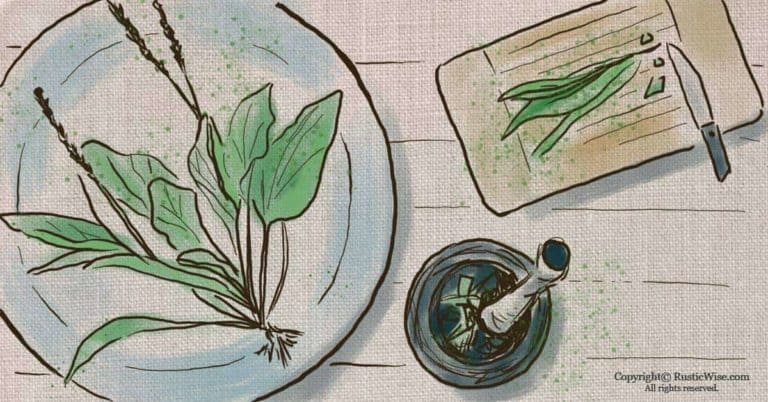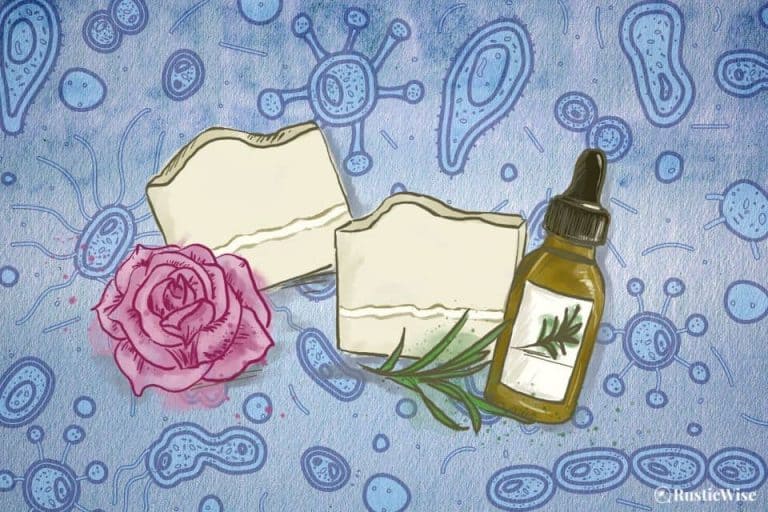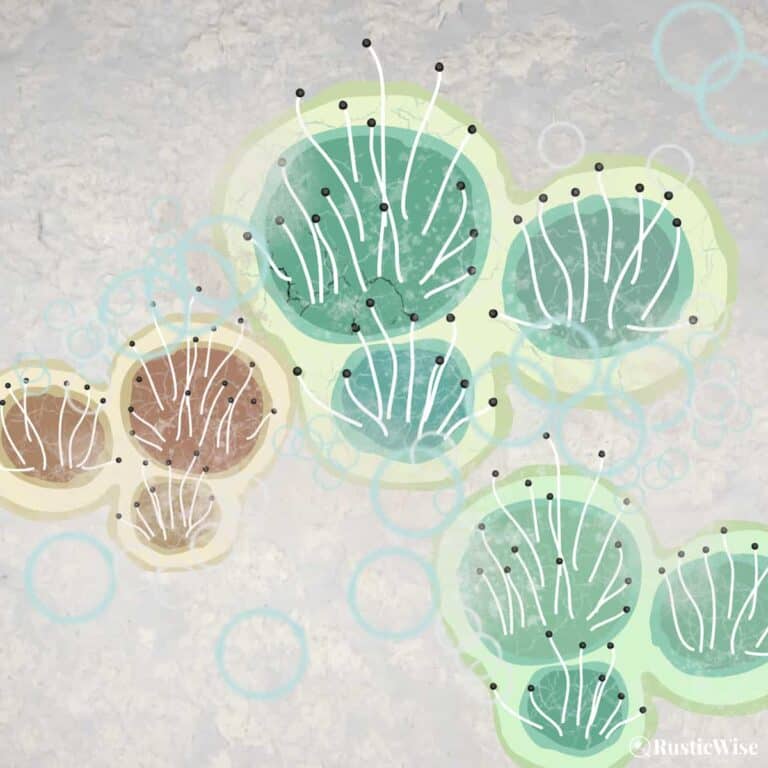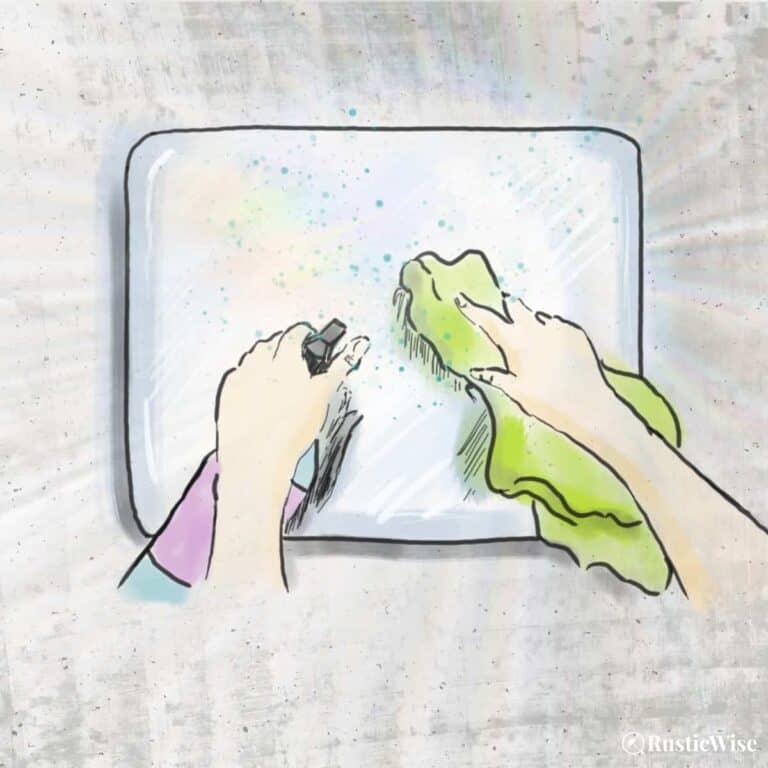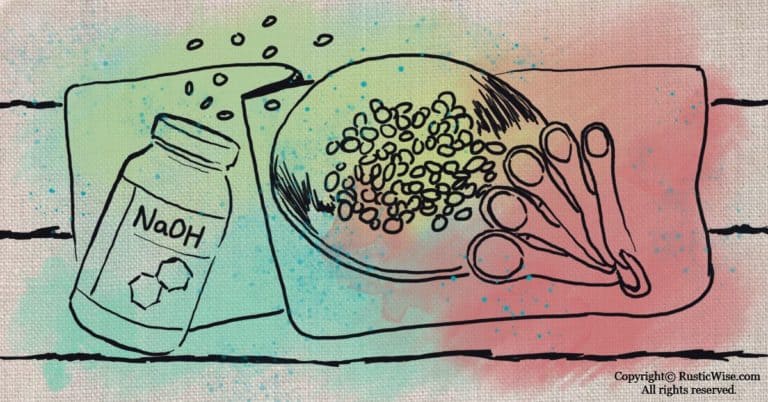3 Simple Ways To Use Soap Nuts for Hair: DIY Natural Shampoo
RusticWise is supported by its readers. When you purchase through links on our site, we may earn an affiliate commission. As an Amazon Associate, we earn from qualifying purchases. Thank You!
Soap nuts or soapberries contain saponins which act as natural surfactants that lift dirt and grease. You may have heard of using soapberries as a natural laundry detergent or all-purpose cleaner, but did you also know you can also use soap nuts for hair? Soapberries have antimicrobial properties and work to safely clean and soothe both hair and scalp.
If you’re looking for a natural shampoo without harsh chemicals and preservatives, you can’t get much more natural than soap nuts. After all, they literally grow on trees.
We’ll show you how to prepare your own homemade soap nuts shampoo using just water and soap nuts in three different ways (boiling, steeping, or grinding into powder).
Read on for more details about this versatile lathering ingredient.
What are soap nuts (aka soapberries)?
Soap nuts are harvested from deciduous trees or shrubs that belong to the genus Sapindus. Soapberry trees grow mainly in tropical and subtropical regions of Asia, the Americas, and Pacific islands.¹
The textured fruit of the soapberry tree may contain up to 37 percent saponin. When combined with water, it produces a soapy lather.¹
There are about 40 types of wild Sapindus trees of which Sapindus mukorossi (S. mukorossi) and Sapindus trifoliatus (S. trifoliatus) are the most common.²
Also known as reetha or reetha powder in Ayurvedic circles, soap nuts go by many names, including soapberries and washing nuts.
The Sapindus Mukorossi tree is commonly found near the Himalayan mountains and parts of India and Nepal. The “fruits” or nuts are picked and left to sun-dry. The seeds are removed—the dried shells or husks are what we use to make natural soap or shampoo.
When dried, the husks are golden brown. Soapberries are a great alternative to chemical-filled products for cleaning.
Did you know … Soap nuts are not actually nuts at all—think of it as a soap berry. They are the dried berries that are harvested from soapberry trees. If you have a nut allergy, you don’t have to worry about an allergic reaction. Soap nuts are safe for most skin types, including those with sensitive skin.
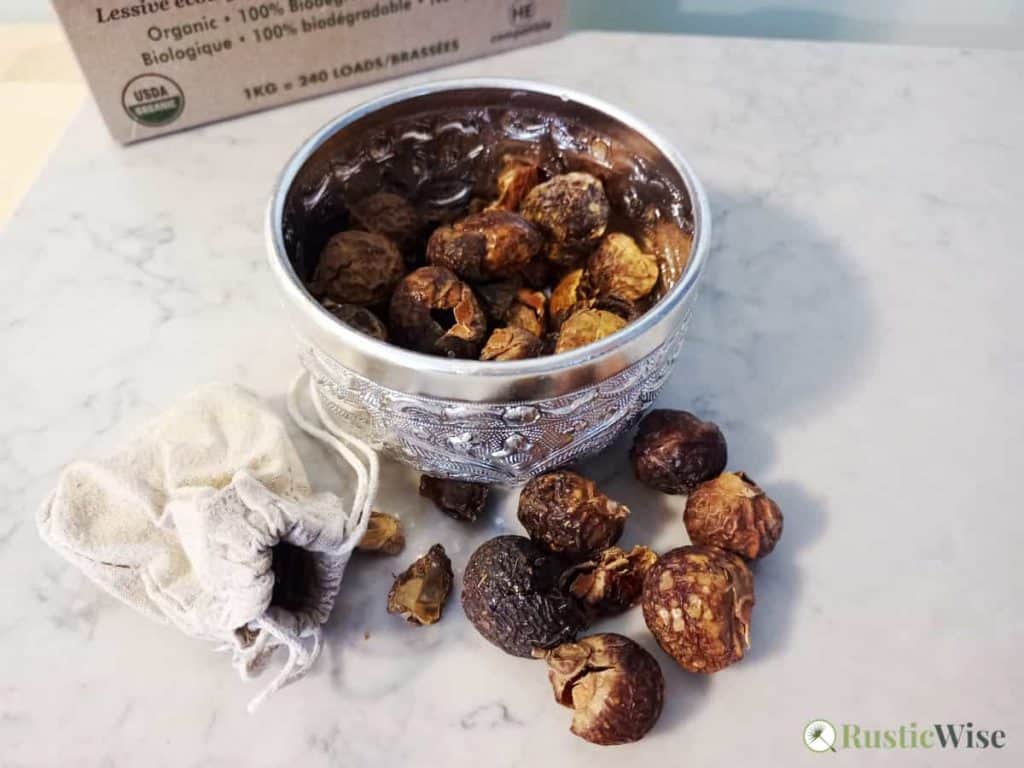
Common uses of soap nuts
The berries of this ancient tree have many practical uses.³
- Natural detergent: Laundry day is a lot more eco-friendly when using soapberries (no plastic or chemicals!). Soap nuts are especially great for washing clothes made of natural fibers such as cotton, linen, and hemp. It forms a mild lather that’s also suitable for washing delicates. Native Americans have long used the fruits of the soapberry tree as a soap alternative. Simply grab a few berries, place in a small muslin bag, and add to your washing machine.
- Shampoo: Want to add a completely natural shampoo to your hair care routine? Antimicrobial properties present in soap nuts make it great for managing dandruff and gently cleansing hair. Using soapberries as a natural beauty product has been a part of natural Ayurvedic practices for centuries.
- Body wash or hand soap: Mild enough for skin, you can make a liquid soap from boiled soap nuts to use as an all-over body wash or liquid hand wash.
- Lice treatment: With insecticidal properties, head lice is treated with a few uses of a concentrated soap nut solution.
- Insecticide: Soap nut liquid helps emulsify and enhance natural insecticide solutions.
- Jewelry polish: The natural cleansing properties of soapberries clean and polish jewelry.
Are soap nuts safe to use for hair and skin?
Yes, soap nuts are safe for both skin and hair. The pH of soap nuts range from 3.8 to 5.1, which makes it acidic.⁴ You may know that the pH of hair and skin is naturally acidic. The acid mantle on skin is a natural barrier that protects the body from harmful bacteria.
When you use a soap or shampoo that’s close to skin’s natural acidity, there’s less disruption to the body’s acid mantle. Slightly acidic products jive better with hair and skin.
If you recall, the pH scale ranges from 0 to 14. A pH 7 is neutral, while numbers above pH 7 are alkaline or basic. Numbers below pH 7 are acidic.
I’ve been using soap nuts as a laundry detergent for years. My daughter has a trio of common ailments: allergies, eczema, and asthma. So, after reading up about the chemicals in dryer sheets and commercial laundry detergent, I decided to ditch them.
I started using soap nuts and wool dryer balls and have no regrets.
Her eczema flares have calmed down, and she has experienced less flaky, dry skin.
Soap nuts for hair benefits
After using soapberries instead of commercial detergents for years, I started hearing more about how it also makes a great hair shampoo.
Are soap nuts good for hair? Simply put, yes. Their gentle cleansing properties work to clean hair and scalp, while its acidic pH level jives with the slightly acidic nature of your tresses and skin.
Here are a few benefits of soap nuts and reasons to give these little nuts a try:
- Biodegradable and eco-friendly: If you’re looking for a natural way to keep hair clean and healthy, I can’t think of a more back-to-nature approach than soapberries. There are no synthetic or harmful chemicals such as sulfates, preservatives, or additives. There’s no plastic packaging to deal with. And once you’ve used your soap nuts, you can simply toss them into your backyard compost!
- Get naturally healthy hair: If you’ve tried the no-poo method and found your hair still in need of some cleansing power from time to time, soap nuts are a natural alternative to normal shampoo. I find that soapberries make my hair shiny and soft. This makes sense, as the pH of soap nuts is acidic. The acidic nature helps close the hair cuticle, making it smooth and shiny.
- Mild cleanser: Most soapberry packages market the product as gentle enough for a baby. If it’s gentle enough for a baby’s skin or children’s clothing, it’ll also work for those with sensitive skin or psoriasis. Natural saponins and water are all you’re putting onto your skin and hair.
- Antibacterial and antimicrobial properties: Recent studies show that saponins from the S. mukorossi tree have medicinal properties that inhibit tumor growths. The antibacterial and antimicrobial properties work to soothe dandruff or dry scalp. It’s also great for those with eczema and psoriasis.²
- Rich in vitamins: The fruits of the soapberry tree contain vitamins A, D, E, and K which stimulate healthy hair growth.
- Lice treatment: The insecticidal properties of these fruits are used to ward off parasitic lice insects on hair and scalp.³
3 ways to use soap nuts for hair
There’s more than one way to use soap nuts for hair. You can try which method works best for you.
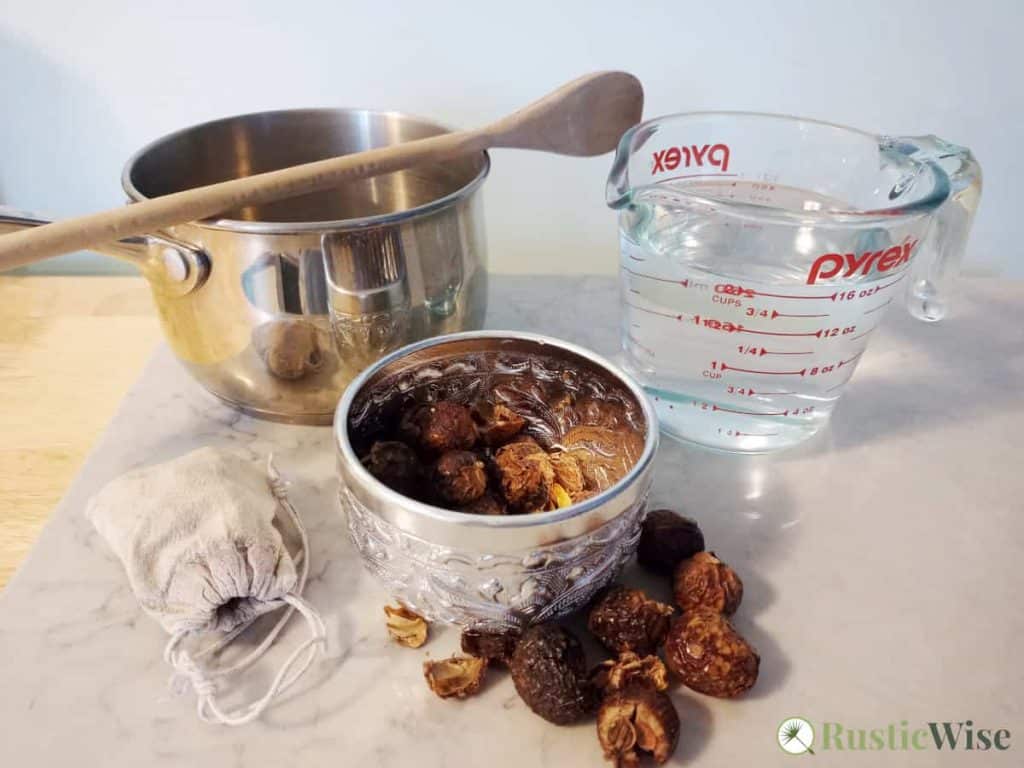
Method #1: Easy soap nut shampoo recipe using boiling/decoction
This first method involves boiling soap nuts to make a decoction. The heat helps release the natural saponins within the husks.
Most soap nut packages come with a small fabric drawstring pouch that fits several soap nuts. You can use this pouch to skip the straining step—easy-peasy! (If you don’t have a pouch, no worries, you can just strain afterwards.)
You’ll need:
- Small saucepan
- Small fabric pouch (or sieve if you don’t have a pouch)
- Between 5 to 10 soap nuts (adjust accordingly depending on if your water is hard or soft)
- Wooden spoon
- Roughly 2 ½ cups water (591 milliliters)
- Optional: 2–4 drops of your favorite essential oil (good choices include lavender essential oil, peppermint essential oil, or rosemary essential oil)
- A small squeeze bottle or cup to bring in the shower with you (avoid glass which might shatter)
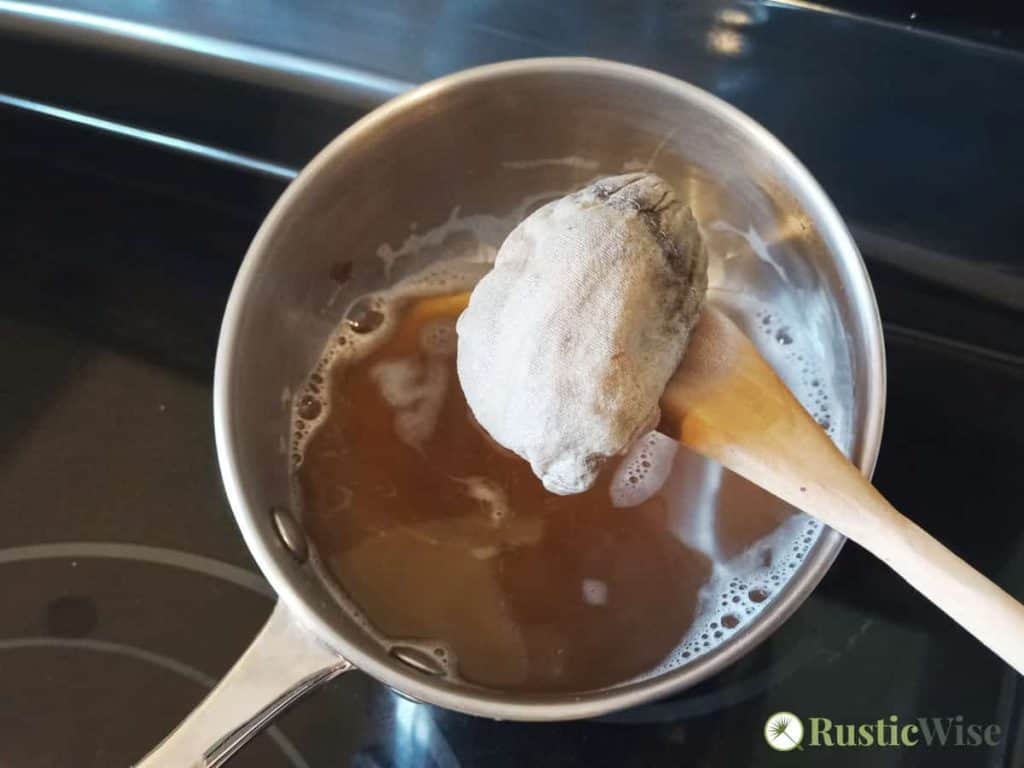
- Fill saucepan with water. Fill the pouch with several soap nuts and place in the water.
- Bring to a boil. Reduce heat to medium-low so the water comes to a rolling boil. Let the soap nuts boil for 10–15 minutes. Periodically use your spoon to stir and press the soapberries to release saponin.
- Carefully remove the pouch with spoon and place the whole pouch onto a plate to air dry. You can use your soap nuts more than once!
- Remove from heat. Let the liquid soap nut mixture cool. Add any essential oils to the cooled mixture.
- Pour your shampoo into a container, such as a cup or squeeze bottle. (See the section below for instructions on how to use soap nuts for hair.)
Note: You might wonder how many shampoos the recipe above lasts for? For me, this recipe lasts three or four shampoos. I have long, thick hair, and I find if I pour the shampoo into squeeze bottles, it lasts longer as I can target it to specific areas. If you’re using a cup to dump over your hair liberally, you might use this all in one go! But, this really depends on how much shampoo you like to use!
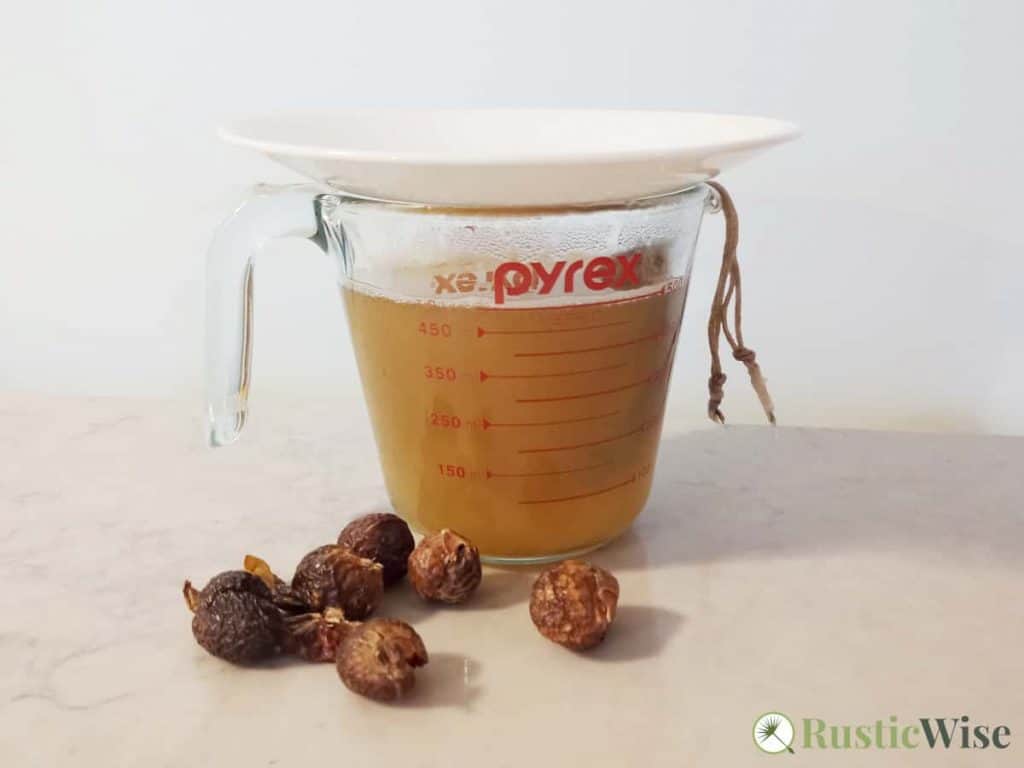
Method #2: Overnight steeping
This is a more hands-off approach if you don’t feel like waiting for your water to boil and cool. Simply boil some water and put your soapberry pouch into the hot water to let it steep overnight.
You may not get as much of the saponins with this method (I feel that method #1: boiling still works best). But this still works fine!
You’ll need:
- Small saucepan or heat-proof container such as a Pyrex glass measuring cup
- A lid or a small plate to cover the top
- Small fabric pouch (or sieve if you don’t have a pouch)
- Between 5 to 10 soap nuts (adjust accordingly depending on your water is hard or soft)
- Roughly 2 ½ cups water (591 milliliters)
- Optional: 2–4 drops of essential oil (good choices include lavender essential oil, peppermint essential oil, or rosemary essential oil)
- Boil water. The easiest thing is to use an electric kettle if you have one.
- Put the soap nuts into the drawstring pouch and place in your heat-safe container.
- Pour boiling water into the container. Cover the container and leave overnight.
- Your pressed liquid is ready to use the next morning. Press the soapberries with a spoon to release more saponins and mix well. Add any essential oils to the cooled mixture.
- Pour your shampoo into a container, such as a cup or squeeze bottle. (See the section below for instructions on how to use soap nuts for hair.)
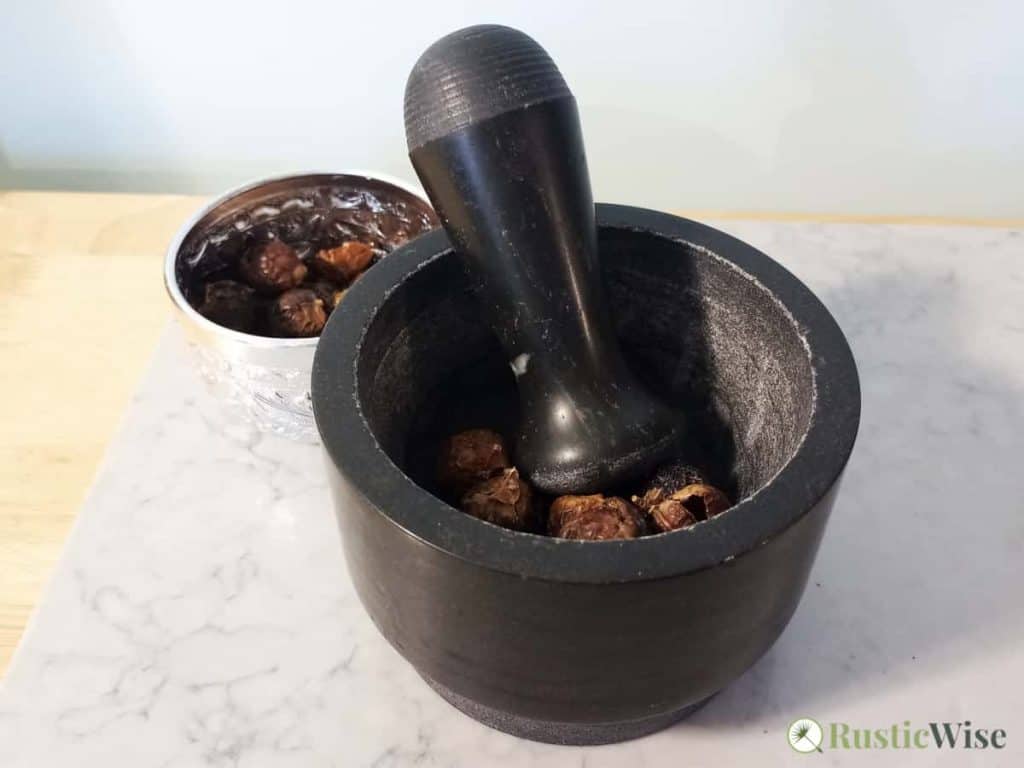
Method #3: Grind it into powder
If you’re tired of doing the whole boiling and waiting game before every hair wash, this method is for you! Powdered soap nut can last for at least a year if stored properly in an airtight container such as a glass jar. Store in a cool, dry place.
You’ll need:
- Coffee grinder, or blender, or mortar and pestle
- Soap nuts
- Storage container
- Strainer
- Measuring spoons
- Warm water
- Use either a coffee grinder or blender to finely grind the dried soap nuts into a powder. You’ll want to use a dedicated coffee grinder for this purpose as you don’t want your next cup of joe tasting funny! Alternatively, you could use a mortar and pestle, but this will require some elbow grease and will result in larger chunks. You can make a larger batch as this dried powder stores well.
- Store soap nut powder in an airtight container.
- To make a fresh batch of natural shampoo, you’ll need between 2 teaspoons to 2 tablespoons of ground powder, depending on your length of hair. Mix with anywhere from 1 cup to 2 ½ cups of WARM water. It’s important to use warm water (not cold) as it helps to release the saponins. You’ll need to experiment with the proportions to see what works best for you!
- Mix your powdered solution well and let it sit for 5 minutes.
- Strain and add any essential oils to the mixture. Pour your shampoo into a container, such as a cup or squeeze bottle. (See the section below for instructions on how to use soap nuts for hair.)
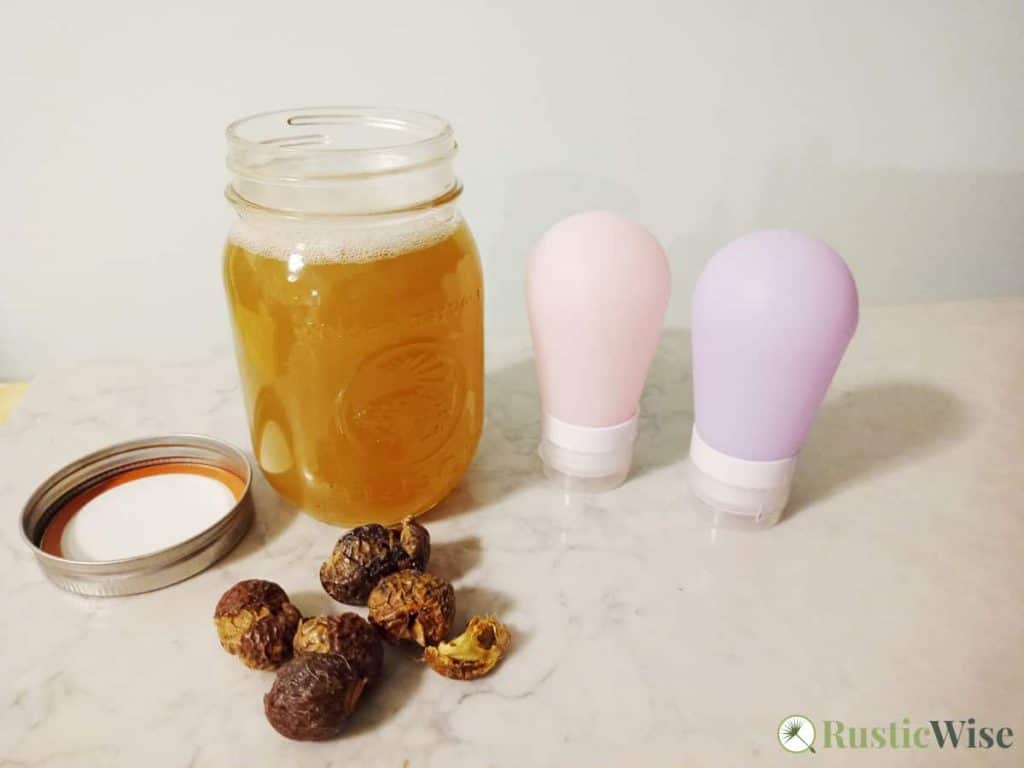
How to shampoo your hair with soap nuts
If you find your hair is greasy, or if you wash your hair only once a week, you’ll want to let the soap nuts soak in your hair for around 10 minutes before stepping into the shower.
Squirt a small amount of the soapberry shampoo onto your scalp and massage gently in. Let it sit for at least 10 minutes. This lets the soap work its magic.
Once you’re in the shower, massage some more shampoo onto the top of your hair and scalp. The soap nuts will form a very mild lather at this point. Tip your head back, close your eyes, and pour the rest of the mixture over your hair in the shower. Let the mixture sit for 1–2 minutes.
There’s no need to vigorously scrub your scalp as with traditional shampoos. You’ll want to avoid scrubbing too much as this can cause hair to tangle. Rinse thoroughly—your hair will feel smooth again!
You’ll find that this DIY shampoo won’t lather like other store-bought shampoos, as it doesn’t contain synthetic surfactants. This is normal!
You might like
Organic Soap Nuts/Soapberries – 1 lbs. (240 loads)
- Premium de-seeded, wild-harvested, sun-dried Sapindus Mukorossi fruit from the Himalayas of India and Nepal. Packaged in the USA.
- Includes 1 oz. travel size Extreme 18X Liquid Soap Nuts ($5.90 value), ONE (1) large 3-1/4 x 4 3/4 Wash Bag, 8 page instruction and informational pamphlet.
Found on Amazon
Check Current Price
Those in Canada and the UK should be taken to the product listing in your region.
Follow with an apple cider vinegar rinse
This is optional, but your hair may benefit from an apple cider vinegar (ACV) rinse periodically. This helps remove impurities and close the hair shaft, making it shinier and smoother.
Apple cider vinegar rinse recipe
- 3–4 tablespoons of ACV
- 1 ½ to 2 cups water
- Optional: 1 or 2 drops of lavender or rosemary essential oil
Combine apple cider vinegar and water. Pour the ACV rinse into a clean squeeze bottle and apply to wet hair after shampooing. Let the mixture sit for a couple minutes, then rinse thoroughly.
Tips on using soap nuts for hair
- Be careful not to get any in your eyes! Just like other shampoos, it stings!
- Don’t expect this DIY shampoo to foam and lather like regular store-bought liquid shampoos, and this won’t disappoint.
- If you’re storing your soap nut shampoo in the fridge, let it sit at room temperature for about an hour. This isn’t necessary, but the liquid will feel cold on your scalp!
- Before using your soap nut shampoo, give it a gentle swirl in the container.
- If you find your hair is dry afterwards, use a few drops of nourishing oils such as coconut oil, jojoba oil, or sweet almond oil. Just use a little and focus on the ends of your hair as you don’t want to leave your hair greasy. It’s best to do this at night to let the oil absorb in. When you awaken the next morning, your hair should feel nourished and clean!
How long can you store liquid soap nut shampoo?
You can store your liquid DIY soapberry shampoo for up to 1 week at room temperature. Or, you can keep it in the fridge for up to 2 weeks. But, you’ll find it works best if used fresh. Discard any solution that looks slimy, or becomes smelly.
Related questions
What other plants contain natural saponins?
Soapwort is another plant rich in saponins. You can make a natural soapwort soap by making a decoction from the stems, leaves, and root.
What do soap nuts smell like?
Soap nuts and liquid soap nut shampoo have a mild, earthy aroma, with a hint of fruitiness. It’s not overwhelming, or unpleasant—it smells of nature!
How many times can you use soap nuts?
I personally use each soap nut two or three times before I add them to the compost pile. (I’ve heard of people using them for five or six times!) Of course, this depends on what you’re using them for, and whether you have hard water.
To check if there are still saponins remaining, gently squeeze soap nuts when they’re still wet (after you’ve just used them). If there’s still life left in them, you’ll notice small bubbles.
How often should you use soap nuts on your hair?
You can use hair soap nuts as often as you would use regular shampoo. Whether you wash your hair normally every day, or once a week, shampoo from soap nuts is mild and gentle enough for regular use.
Do you really need to use a vinegar hair rinse afterwards?
No, you don’t need to use a vinegar rinse—some people find that their hair is soft and shiny using just the soapberry shampoo by itself. A vinegar hair rinse is helpful in closing the hair shaft and making it smoother. I like to use a vinegar rinse as I have long, thick hair that’s prone to tangles. But feel free to skip the ACV rinse, or use only as needed!
👉 Find more Natural Wellness topics on nourishing your body and soul with natural food, herbs, and plants. 🌿
New to making soap? 🧼❓
👉We have a fantastic overview on the whole soapmaking process here: read our Timeless Guide To Soapmaking.
If you would like to see our soapmaking posts organized by topic type, see our Soapmaking Collection.
Would you like more timeless tips via email?
Fun tips to help you live an independent, self-sustaining lifestyle. Opt-out at any time.


References
- Britannica, Soapberry Plant, https://www.britannica.com/plant/soapberry. Accessed April 2023.
- Chen, Chang-Chih et al. “Effects of Sapindus mukorossi Seed Oil on Skin Wound Healing: In Vivo and in Vitro Testing.” International journal of molecular sciences vol. 20,10 2579. 26 May. 2019, doi:10.3390/ijms20102579
- Plants For a Future, Sapindus mukorossi – Gaertn., https://pfaf.org/user/Plant.aspx?LatinName=Sapindus+mukorossi. Accessed April 2023.
- Seed Legend, FAQ, https://seedlegend.com/pages/faq. Accessed April 2023.

Author: Theresa Tesolin
Theresa is co-founder of RusticWise. She helps people unleash their inner DIY spirit by encouraging them to get dirty and make or grow something from scratch.



